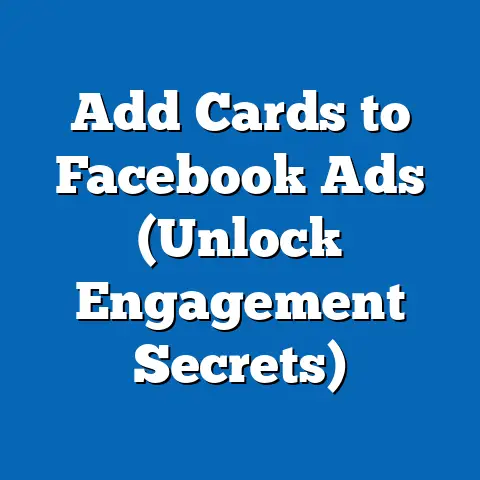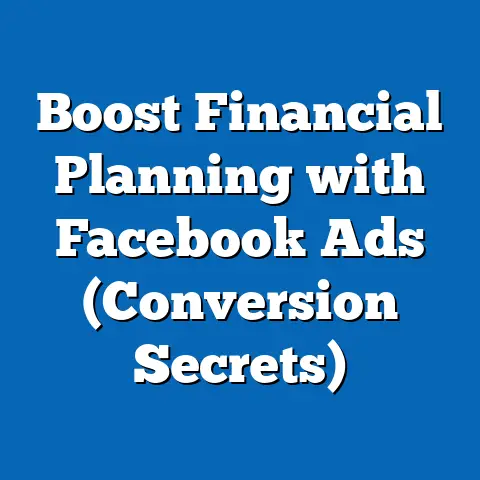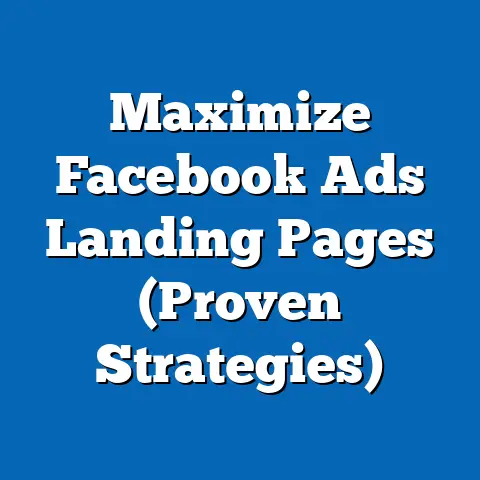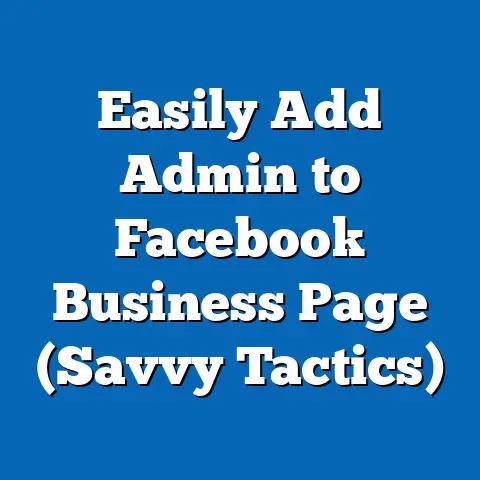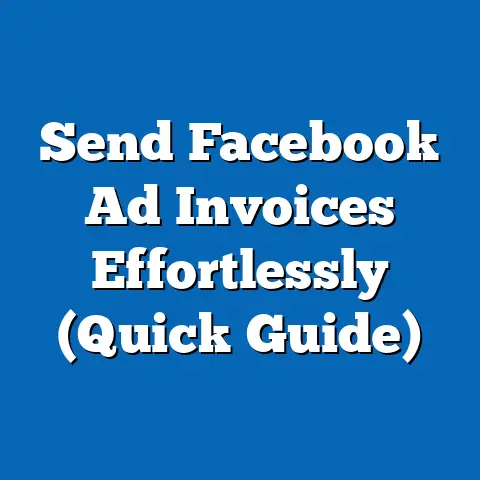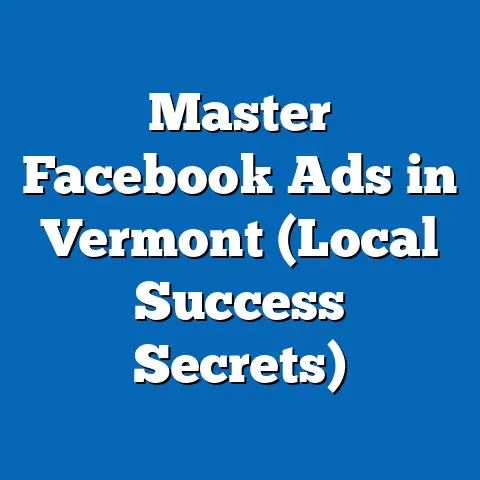Winning Facebook Ad Examples (Proven Strategies Inside)
The digital landscape is a battlefield, and as marketers, we’re constantly vying for attention. Nowhere is this truer than on social media, especially Facebook. Think about it: users are bombarded with countless posts, updates, and yes, ads, every single day. It’s a chaotic, noisy environment, and cutting through that noise to connect with your target audience feels like an uphill battle.
Businesses pour time, money, and resources into Facebook advertising, hoping to tap into the platform’s massive reach. With billions of users worldwide, the potential for growth, brand awareness, and customer engagement is undeniably huge. But that potential comes with a catch: if your ads are ineffective, they’ll simply get lost in the shuffle, a wasted investment in a platform that could be a goldmine.
So, how do you break through the clutter? How can you stand out in a sea of sameness and create ads that not only grab attention but also convert viewers into loyal customers? The answer, my friends, lies in understanding what works. It’s about learning from the successes of others, dissecting winning strategies, and applying those lessons to your own campaigns.
That’s exactly what I’m going to explore in this article. I’m not just going to show you a bunch of pretty pictures and tell you they’re “good ads.” Instead, I’m going to delve deep into the why behind their success. We’ll analyze real-world examples, break down the strategies they employed, and uncover actionable insights that you can implement in your own Facebook advertising efforts. Get ready to level up your ad game!
Understanding Facebook Ads
Facebook advertising has come a long way since its humble beginnings. What started as simple banner ads has evolved into a sophisticated, multi-faceted platform with a range of ad formats, targeting options, and optimization tools. It’s a far cry from the early days, and understanding its current state is crucial for success.
Today, Facebook ads are an indispensable part of any comprehensive digital marketing strategy. Their power lies in their precision targeting capabilities. You can target users based on demographics, interests, behaviors, and even custom audiences built from your own customer data. This level of granularity allows you to reach the right people with the right message at the right time, maximizing the impact of your ad spend.
There’s a whole buffet of ad formats available, each designed to achieve different marketing objectives. Here’s a quick rundown:
- Image Ads: These are the simplest form of Facebook ads, featuring a single image and accompanying text. They’re great for visual storytelling and showcasing products.
- Video Ads: Video is king in the digital world, and Facebook video ads are a powerful way to capture attention and convey your message in a dynamic and engaging way.
- Carousel Ads: These ads allow you to display multiple images or videos in a scrollable format. They’re perfect for showcasing a range of products or telling a story in sequential steps.
- Collection Ads: Designed for e-commerce, these ads feature a main image or video followed by a collection of related products. They provide a seamless shopping experience directly within Facebook.
- Lead Ads: Ideal for lead generation, these ads feature a built-in form that allows users to submit their contact information directly within Facebook.
- Instant Experience Ads: These are full-screen, mobile-optimized experiences that load instantly when someone clicks on your ad. They’re a great way to create immersive and engaging brand experiences.
The benefits of each ad type are unique. Image ads are quick to create and visually appealing, video ads are great for grabbing attention, and carousel ads are perfect for showcasing multiple products. Collection ads simplify the shopping experience, lead ads streamline lead capture, and Instant Experience ads immerse users in interactive content.
But here’s the thing: having access to all these tools and features doesn’t guarantee success. The real magic happens when creativity and strategy come into play. You need to know your target audience inside and out, understand their needs and desires, and craft ads that resonate with them on a personal level. This requires more than just technical knowledge; it requires a deep understanding of human psychology and compelling storytelling.
Takeaway: Facebook advertising is a powerful tool, but it’s only as effective as the strategy behind it. Knowing your target audience, choosing the right ad format, and crafting compelling creative are all essential ingredients for success.
I’ve scoured the internet, drawn on my own experiences, and hand-picked a selection of ads that I believe exemplify best practices and demonstrate the power of strategic Facebook advertising. I’ve chosen examples from diverse industries to show the breadth of possibilities.For each example, I’ll break down the following key elements:
- Ad Overview: A brief description of the ad, including visuals and copy.
- Objectives: The goals of the ad campaign (brand awareness, lead generation, sales conversion, etc.).
- Target Audience: Who the ad was aimed at and why.
- Performance Metrics: Any available data on how the ad performed (engagement rates, conversion rates, etc.).
- Key Takeaways: What made the ad successful, including creative elements, messaging, and use of Facebook’s features.
Let’s dive in!
Example 1: Dollar Shave Club – The “Our Blades Are F***ing Great” Video Ad
Ad Overview: This ad features a humorous and irreverent video showcasing Dollar Shave Club’s razor blades and subscription service. The video is low-budget but incredibly engaging, with witty commentary and memorable visuals.
Objectives: The primary objective was to drive brand awareness and acquire new subscribers. The ad aimed to disrupt the traditional razor market and position Dollar Shave Club as a fun, affordable alternative to established brands.
Target Audience: The target audience was primarily men aged 18-45 who were tired of paying high prices for razor blades. The ad appealed to a sense of humor and offered a practical solution to a common problem.
Performance Metrics: This ad went viral, generating millions of views and driving a massive influx of new subscribers to Dollar Shave Club. It’s widely considered one of the most successful video ads of all time.
Key Takeaways:
- Humor is powerful: The ad’s irreverent humor resonated with the target audience and made it highly shareable.
- Authenticity matters: The low-budget production value actually added to the ad’s charm and made it feel more authentic.
- Solve a problem: The ad clearly addressed a common pain point (expensive razor blades) and offered a simple, affordable solution.
- Disrupt the status quo: The ad challenged the established razor market and positioned Dollar Shave Club as a fresh, innovative brand.
I remember the first time I saw this ad. I was instantly hooked. The humor was spot-on, the message was clear, and the overall presentation was so unique. It was a masterclass in disruptive marketing.
Example 2: Airbnb – “Live There” Campaign
Ad Overview: This campaign featured stunning photography and videography showcasing unique Airbnb properties in various locations around the world. The ads focused on the experience of “living like a local” rather than just visiting a tourist destination.
Objectives: The primary objective was to increase brand awareness and drive bookings by appealing to travelers seeking authentic and immersive experiences.
Target Audience: The target audience was travelers aged 25-55 who were interested in unique accommodations and local experiences. The ads targeted users with interests in travel, culture, and adventure.
Performance Metrics: This campaign significantly increased brand awareness for Airbnb and drove a substantial increase in bookings. It helped position Airbnb as a leader in the alternative accommodation market.
Key Takeaways:
- Focus on the experience: The ads emphasized the unique experiences that Airbnb offered, rather than just the properties themselves.
- Visual storytelling: The stunning photography and videography created a sense of wanderlust and inspired viewers to book their next trip.
- Appeal to emotions: The ads tapped into the desire for authentic travel experiences and the feeling of “belonging” in a new place.
- Targeted messaging: The ads were tailored to specific interests and demographics, ensuring that the message resonated with the target audience.
I’ve always admired Airbnb’s marketing. They understand the power of storytelling and visual appeal. Their “Live There” campaign was a stroke of genius, tapping into the desire for authentic travel experiences.
Example 3: Old Spice – “The Man Your Man Could Smell Like” Campaign
Ad Overview: This campaign featured a series of humorous and surreal video ads starring Isaiah Mustafa as “The Old Spice Guy.” The ads were highly interactive, with Mustafa responding to comments and questions from viewers in real-time.
Objectives: The primary objective was to revitalize the Old Spice brand and appeal to a younger audience. The ads aimed to position Old Spice as a cool and desirable brand for men.
Target Audience: The target audience was primarily women aged 18-34, who were the primary purchasers of men’s grooming products. The ads appealed to their sense of humor and desire for a confident and attractive partner.
Performance Metrics: This campaign was a massive success, generating millions of views and driving a significant increase in sales for Old Spice. It helped transform the brand’s image and appeal to a new generation of consumers.
Key Takeaways:
- Target the decision-maker: The ads targeted women, who were the primary purchasers of men’s grooming products.
- Create a memorable character: “The Old Spice Guy” became a cultural icon, instantly recognizable and associated with the brand.
- Embrace interactivity: Responding to comments and questions in real-time created a sense of engagement and excitement.
- Don’t be afraid to be bold: The ads were humorous, surreal, and unapologetically confident, which helped them stand out from the competition.
Old Spice completely reinvented their brand with this campaign. The humor was unexpected, the execution was brilliant, and the results were undeniable. It’s a testament to the power of bold and creative marketing.
Example 4: Warby Parker – Direct Response Ads with Clear Value Proposition
Ad Overview: Warby Parker consistently runs Facebook ads that feature stylish eyewear, clear pricing, and a risk-free trial offer. The ads often include customer testimonials and highlight the company’s social mission.
Objectives: The primary objective is to drive direct sales of eyewear through online and offline channels. The ads aim to generate leads, increase website traffic, and convert viewers into paying customers.
Target Audience: The target audience is typically millennials and Gen Z consumers who are looking for affordable, stylish eyewear with a social conscience. The ads target users with interests in fashion, design, and social responsibility.
Performance Metrics: Warby Parker’s Facebook ads consistently generate high conversion rates and drive significant revenue. The company relies heavily on Facebook advertising to acquire new customers and grow its business.
Key Takeaways:
- Clear value proposition: The ads clearly communicate the benefits of Warby Parker’s eyewear, including style, affordability, and social impact.
- Risk-free trial: Offering a risk-free trial reduces the barrier to entry and encourages potential customers to try the product.
- Customer testimonials: Featuring customer testimonials builds trust and credibility.
- Social mission: Highlighting the company’s social mission resonates with socially conscious consumers.
Warby Parker’s success with Facebook advertising is a testament to the power of a clear value proposition and a well-defined target audience. They understand their customers and craft ads that speak directly to their needs and desires.
Example 5: Skillshare – Targeted Ads with Personalized Messaging
Ad Overview: Skillshare runs Facebook ads that promote specific online courses and target users based on their interests and skills. The ads often feature instructors and highlight the practical skills that viewers will learn.
Objectives: The primary objective is to drive sign-ups for Skillshare’s online courses and increase membership subscriptions. The ads aim to generate leads, increase website traffic, and convert viewers into paying subscribers.
Target Audience: The target audience is typically individuals who are interested in learning new skills and pursuing their creative passions. The ads target users with interests in design, photography, writing, and other creative fields.
Performance Metrics: Skillshare’s Facebook ads consistently generate high conversion rates and drive significant revenue. The company relies heavily on Facebook advertising to acquire new customers and grow its business.
Key Takeaways:
- Personalized messaging: The ads are tailored to specific interests and skills, ensuring that the message resonates with the target audience.
- Highlight practical skills: The ads emphasize the practical skills that viewers will learn, appealing to their desire for professional development.
- Feature instructors: Featuring instructors builds trust and credibility.
- Clear call to action: The ads clearly instruct viewers to sign up for Skillshare’s online courses.
Skillshare’s targeted advertising strategy is a great example of how to leverage Facebook’s targeting capabilities to reach the right people with the right message. They understand their audience and craft ads that speak directly to their interests and aspirations.
Takeaway: These examples demonstrate the power of creativity, strategy, and targeted messaging in Facebook advertising. By understanding the objectives, target audience, and key takeaways from these successful campaigns, you can gain valuable insights that you can apply to your own advertising efforts.
Proven Strategies Behind Winning Ads
Now that we’ve analyzed some winning Facebook ad examples, let’s delve into the strategies that underpin their success. I’ve identified five key strategies that consistently appear in successful Facebook ad campaigns:
Compelling Visuals
In the fast-paced world of social media, visuals are king. Your ad has mere seconds to capture someone’s attention as they scroll through their feed. High-quality images and videos are essential for making a strong first impression and drawing viewers in.
- Use high-resolution images: Blurry or pixelated images will instantly turn people off. Invest in professional photography or use high-quality stock photos.
- Create eye-catching videos: Videos are incredibly engaging and can convey your message in a dynamic and memorable way.
- Experiment with different formats: Try different visual formats, such as GIFs, slideshows, or 360-degree images, to see what resonates with your audience.
- Optimize for mobile: Most Facebook users access the platform on their mobile devices, so make sure your visuals are optimized for mobile viewing.
I’ve seen firsthand how a simple change in imagery can dramatically impact ad performance. A high-quality, visually appealing image can increase click-through rates and conversions significantly.
Engaging Copy
While visuals are important, the copy that accompanies your ad is equally crucial. Your copy should be concise, impactful, and relevant to your target audience. It should clearly communicate the benefits of your product or service and entice viewers to take action.
- Write clear and concise headlines: Your headline is the first thing people will see, so make it count. Use strong verbs and highlight the key benefits of your offer.
- Focus on the benefits, not the features: Instead of listing the features of your product, focus on how it will benefit the customer.
- Use a strong call to action: Tell viewers exactly what you want them to do, whether it’s visiting your website, signing up for a newsletter, or making a purchase.
- Personalize your message: Tailor your copy to specific interests and demographics to make it more relevant to the target audience.
I’ve learned that even the most beautiful image can fall flat if it’s paired with weak or uninspired copy. The right words can make all the difference in capturing attention and driving conversions.
Targeting and Segmentation
Facebook’s robust targeting capabilities are one of its greatest strengths. By leveraging these tools, you can reach the right people with the right message at the right time.
- Define your target audience: Before you start creating ads, take the time to define your ideal customer. Consider their demographics, interests, behaviors, and pain points.
- Use Facebook’s targeting options: Facebook offers a wide range of targeting options, including demographics, interests, behaviors, custom audiences, and lookalike audiences.
- Segment your audience: Don’t treat your entire audience as a homogenous group. Segment your audience based on their interests, behaviors, and past interactions with your brand.
- Test different targeting options: Experiment with different targeting options to see what works best for your business.
I’ve seen campaigns go from zero to hero simply by refining the targeting. It’s about finding the sweet spot where your message resonates with the right audience.
A/B Testing and Optimization
No matter how well you plan your Facebook ad campaigns, there’s always room for improvement. A/B testing and optimization are essential for identifying what works and what doesn’t.
- Test different ad variations: Experiment with different headlines, images, copy, and calls to action to see which combinations perform best.
- Track your results: Use Facebook’s analytics tools to track the performance of your ads and identify areas for improvement.
- Optimize your campaigns: Based on your results, make adjustments to your ads to improve their performance.
- Continuously iterate: A/B testing and optimization is an ongoing process. Continuously test and refine your ads to stay ahead of the competition.
I’ve learned that even small changes can have a big impact on ad performance. A/B testing allows you to make data-driven decisions and optimize your campaigns for maximum results.
Brand Consistency
Maintaining brand consistency across your Facebook ads is crucial for building brand recognition and trust.
- Use consistent visuals: Use the same colors, fonts, and imagery in all of your ads to create a cohesive brand identity.
- Maintain a consistent voice: Use the same tone and style in all of your copy to create a consistent brand voice.
- Stay true to your brand values: Make sure your ads reflect your brand values and resonate with your target audience.
- Be authentic: Don’t try to be something you’re not. Be authentic and genuine in your messaging.
I’ve seen brands damage their reputation by running ads that were inconsistent with their overall brand identity. Maintaining brand consistency is essential for building trust and credibility with your audience.
Takeaway: These five strategies – compelling visuals, engaging copy, targeted and segmented audiences, A/B testing and optimization, and brand consistency – are the building blocks of successful Facebook ad campaigns. By mastering these strategies, you can create ads that capture attention, resonate with your target audience, and drive meaningful results.
Common Mistakes to Avoid
Creating winning Facebook ads isn’t just about doing the right things; it’s also about avoiding the wrong ones. I’ve seen countless marketers make the same mistakes over and over again, leading to disappointing results and wasted ad spend. Let’s take a look at some of the most common pitfalls to avoid:
- Neglecting Audience Insights: Jumping into ad creation without thoroughly understanding your target audience is a recipe for disaster. You need to know their demographics, interests, behaviors, and pain points to craft ads that resonate with them.
- Poor Ad Design: A poorly designed ad can instantly turn people off. Blurry images, cluttered layouts, and unreadable fonts can all detract from your message.
- Lack of Clear Objectives: Before you launch a campaign, you need to define your objectives. What do you want to achieve? Brand awareness? Lead generation? Sales conversions? Without clear objectives, you won’t be able to measure your success.
- Ignoring Mobile Optimization: The majority of Facebook users access the platform on their mobile devices. If your ads aren’t optimized for mobile viewing, you’re missing out on a huge opportunity.
- Using Generic Copy: Generic copy that doesn’t speak to the specific needs and desires of your target audience will simply get ignored. You need to craft compelling copy that resonates with your audience and entices them to take action.
- Forgetting a Call to Action: Every ad should have a clear call to action. Tell viewers exactly what you want them to do, whether it’s visiting your website, signing up for a newsletter, or making a purchase.
- Not Tracking Results: If you’re not tracking your results, you won’t know what’s working and what’s not. Use Facebook’s analytics tools to monitor the performance of your ads and identify areas for improvement.
- Giving Up Too Soon: Facebook advertising takes time and effort. Don’t expect to see results overnight. Be patient, persistent, and willing to experiment.
I remember one particular campaign where the client insisted on using a low-resolution image in their ad. Despite my warnings, they refused to budge. Unsurprisingly, the ad performed poorly, and we had to scramble to replace the image with a higher-quality version. It was a costly lesson, but it reinforced the importance of paying attention to the details.
Takeaway: Avoiding these common mistakes is just as important as implementing the right strategies. By being mindful of these pitfalls, you can increase your chances of creating successful Facebook ad campaigns.
Conclusion
Facebook advertising is a complex and ever-evolving landscape. The competition is fierce, and standing out from the crowd requires creativity, strategy, and a willingness to learn from the successes of others.
Throughout this article, I’ve shared a selection of winning Facebook ad examples and delved into the proven strategies that underpin their success. We’ve explored the importance of compelling visuals, engaging copy, targeted messaging, A/B testing, and brand consistency. We’ve also identified common mistakes to avoid, such as neglecting audience insights, using poor ad design, and forgetting a call to action.
The key takeaway is that Facebook advertising is not a “set it and forget it” activity. It requires ongoing effort, experimentation, and optimization. You need to be constantly testing new ideas, tracking your results, and refining your approach.
While the competition on Facebook may be intense, understanding these proven strategies can significantly increase your chances of creating successful ad campaigns. By learning from the examples of others, implementing best practices, and avoiding common mistakes, you can create ads that not only capture attention but also drive meaningful results for your business.
So, I encourage you to refine your approach, test new ideas, and ultimately create ads that not only stand out but drive results. The potential rewards are immense, and with the right strategies in place, you can unlock the power of Facebook advertising to grow your business and achieve your marketing goals. Now go out there and create some winning ads!

